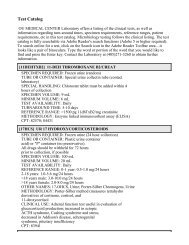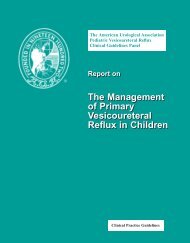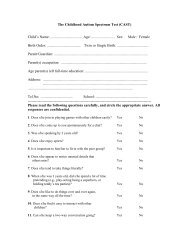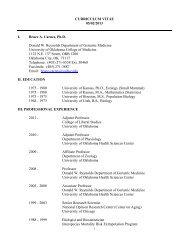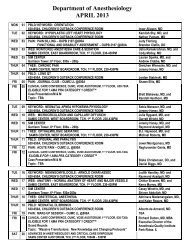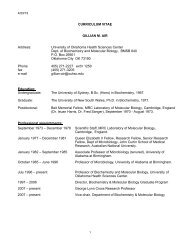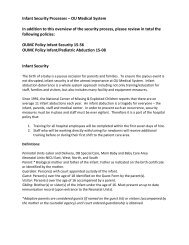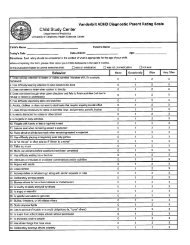Mary Beth Humphrey, MD, PhD - OU Medicine
Mary Beth Humphrey, MD, PhD - OU Medicine
Mary Beth Humphrey, MD, PhD - OU Medicine
You also want an ePaper? Increase the reach of your titles
YUMPU automatically turns print PDFs into web optimized ePapers that Google loves.
<strong>Mary</strong> <strong>Beth</strong> <strong>Humphrey</strong>, <strong>MD</strong>, <strong>PhD</strong><br />
Associate Professor, Department of <strong>Medicine</strong>, Rheumatology and Immunology<br />
SECTION: Rheumatology<br />
CERTIFICATIONS: Rheumatology<br />
Internal <strong>Medicine</strong><br />
ADDRESS: 975 N.E. 10 th St, BRC209<br />
Oklahoma City, OK 73104<br />
OFFICE PHONE: 405-271-8001x35290<br />
FAX: 405-271-3229<br />
E-MAIL: e-Mail Dr. <strong>Humphrey</strong><br />
Dr. <strong>Humphrey</strong> is a physician scientist at <strong>OU</strong>HSC since her relocation from the University of California at San Francisco in 2006.<br />
She holds the James R. McEldowney Endowed Chair in Immunology and serves on a number of national committees, including<br />
the National Institute of Dental and Craniofacial Research Special Grants Review Committee, the American Society of Bone and<br />
Mineral Research Women’s Committee, and the Scientific Advisory Committee for the International Bone and Mineral Society<br />
Sun Valley Musculoskeletal Workshop. Locally, she serves on the OCAST Health Research Committee. She has won numerous<br />
research awards including the Ephraim Engleman Award for Excellence in the Field of Arthritis and the Presidential Early Career<br />
Award in Science and Engineering (PECASE) awarded by President Bush in 2008. In addition to her active research program, Dr.<br />
<strong>Humphrey</strong> participates in clinical duties in the Rheumatology Fellowship Program and the Department of <strong>Medicine</strong>.<br />
EDUCATION:<br />
August 1988- June 30, 1997 <strong>MD</strong>, <strong>PhD</strong>, Baylor College of <strong>Medicine</strong>, Houston, Texas<br />
July 1, 1997 – June 30, 1998 <strong>Medicine</strong> Internship, University of California, San Francisco, California<br />
July 1, 1998 – June 30, 2000 <strong>Medicine</strong> Residency, University of California, San Francisco, California<br />
July 1, 2000 – June 30, 2001 Chief Medical Resident, San Francisco General Hospital, UCSF, San Francisco<br />
July 1, 2001 – June 30, 2004 Fellow, Division of Rheumatology, Department of <strong>Medicine</strong>, University of<br />
California, San Francisco, California<br />
CLINICAL INTERESTS:<br />
General Rheumatology<br />
RESEARCH INTERESTS:<br />
Dr. <strong>Humphrey</strong>’s research program centers on two main themes: Osteoimmunology and Systemic Lupus Erythematosus (SLE).<br />
Osteoimmunology is the study of bone, bone cells, and the immune system. Recent studies have highlighted the importance of<br />
normal bone and bone cells to maintain hematopoietic stem cell niches. Immune cells including macrophages, dendritic cells,<br />
and T cells also actively participate in abnormal bone responses as seen in diseases such as rheumatoid arthritis. Dr. <strong>Humphrey</strong><br />
is focusing on the role of immunoreceptor tyrosine-based activation motif (ITAM)-containing adapters and their receptors in<br />
controlling osteoclast differentiation and activation. . Her studies thus far have revealed unique requirements for the ITAMadapters<br />
in osteoclast biology and in vivo bone remodeling. Additional studies are aimed at determining the role of ITAMadapters<br />
in the negative regulation of Toll-like receptor (TLR) signaling.<br />
The second main thrust of the <strong>Humphrey</strong> lab is aimed at determining the causal relationship between small nucleotide<br />
polymorphism (SNPs) in the TNFAIP3 gene and their relationship to SLE. TNFAIP3 encodes an ubiquitin modifying protein, A20,<br />
a critical negative regulator of cellular activation downstream of TLRs and Tumor necrosis factor family receptors, among<br />
others. Studies are underway to identify functional consequences in immune cells expressing the risk allele of TNFAIP3. Results<br />
of these studies will further our understanding of the mechanisms driving the development of SLE and may lead to new<br />
therapeutic targets to control the disease.<br />
RECENT PUBLICATIONS:<br />
<strong>Humphrey</strong>, M.B.*, D.H. Chung*, M. C. Nakamura, D. G. Ginzinger, W. E. Seaman, M. R. Daws. CMRF-35-Like Molecule-1, a novel<br />
mouse myeloid receptor, can inhibit osteoclast formation. Journal of Immunology. 2003, 171: 6541-6548. (* Co-first authors)
<strong>Humphrey</strong>, M.B., K. Ogasawara, W. Yao, S. C. Spusta, M. R. Daws, N. E. Lane, L. L. Lanier, M. C. Nakamura. The Signaling Adapter<br />
Protein DAP12 Regulates Multinucleation During Osteoclast Development. Journal of Bone and Mineral Research. 2004,<br />
19:224-234. Published on line December 16, 2003 doi 10.1359/JBMR0301234.<br />
<strong>Humphrey</strong>, M. B.*, A. Mócsai*, J.A.G. Van Ziffle, Y. Hu, A. Burghardt, S. Spusta, S. Majumdar, L. L. Lanier, C. A. Lowell, M. C.<br />
Through the Syk Tyrosine Kinase. Proceedings of the National Academy of Sciences. 2004, 101:6158-6163. (* Co-first authors)<br />
Lane, N. E., W. Yao, M. C. Nakamura, M. B. <strong>Humphrey</strong>, D. Kimmel, X. Huang, d. Sheppard, P.F. Ross, and S. L. Teitelbaum. Mice<br />
lacking Integrin<br />
Journal of Bone and Mineral Research. 2005, 20:58-66. Published on line October 25, 2004 doi 10.1359/JBMR041017.<br />
<strong>Humphrey</strong>, M.B., M. R. Daws, S. C. Spusta, E. C. Niemi, J. A. Torchia, L. L. Lanier, W. E. Seaman, and M. C. Nakamura. TREM2, a<br />
DAP12-associated Receptor, Regulates Osteoclast Differentiation and Function. Journal of Bone and Mineral Research, 2006,<br />
21:237-245. Published on line October 24, 2005 doi 10.1359/JBMR.051016.<br />
Hamerman, J.A., J. R. Jarjoura, M.B. <strong>Humphrey</strong>, M.C. Nakamura, W.E. Seaman and L.L. Lanier. Cutting Edge: Inhibition of TLR<br />
and FcR responses in macrophages by TREM-2 and DAP12. Journal of Immunology, 2006, 177(4):2051-5.<br />
Wu, Y., J.A. Torchia, W. Yao, N.E. Lane, L.L. Lanier, M.C. Nakamura, and M.B. <strong>Humphrey</strong>. Bone Microenvironment Specific<br />
Roles of ITAM Signaling In Bone Remodeling Induced by Acute Estrogen-deficiency. Public Library of Science ONE, 2007,<br />
2(7):E586. doi:10371/journal.pone.0000586.<br />
Charles, J.F., M.B. <strong>Humphrey</strong>, X. Zhao, E. Quarles, M.C. Nakamura, A. Aderem, W.E. Seaman, K.D. Smith. The innate immune<br />
response to Salmonella by macrophages is dependent on TREM2-DAP12. Infection and Immunity, 2008, Apr 7 [Epub ahead of<br />
print] PMID: 18391000<br />
Bates, JS, CJ Lessard, JM Leon, T Nguyen, LJ Battiest, J Rodgers, KM Kaufman, JA James, GS Gilkeson, JA Kelly, MB <strong>Humphrey</strong>, JB<br />
Harley, C Gray-McGuire, KL Moser1and PM Gaffney. Meta-analysis and imputation identifies a 109 kb risk haplotype spanning<br />
TNFAIP3 associated with lupus nephritis and hematologic manifestations. Genes and Immunity, 2009, 10: 470-477.<br />
Park-Min, K.H., J.D. Ji, T. Antoniv, A.C. Ried, R. B. Silver, M.B. <strong>Humphrey</strong>, M. Nakamura, and L.B. Ivashkiv. IL-10 suppresses<br />
calcium-mediated costimulation of receptor activator NF-kB signaling during human osteoclast differentiation by inhibiting<br />
TREM-2 Expression. Journal of Immunology, 2009, 183:2444-2455.<br />
Peng, Q., Coggeshall, K.M., Torchia, J.A., and M.B. <strong>Humphrey</strong>. TREM2- and DAP12-Dependent Activation of PI3K Requires<br />
DAP10 and is Inhibited by SHIP1. Science Signaling, May, 2010, (3) 122<br />
Chang JL, Brauer DS, Johnson J, Chen CG, Akil O, Balooch G, <strong>Humphrey</strong> MB, Chin EN, Porter AE, Butcher K, Ritchie RO, Schneider<br />
RA, Lalwani A, Derynck R, Marshall GW, Marshall SJ, Lustig L, Alliston T. Tissue-specific calibration of extracellular matrix<br />
material properties by transforming growth factor-β and Runx2 in bone is required for hearing. EMBO Rep. Sept 2010 [Epub<br />
ahead of print]PMID: 20847738<br />
Adrianto, Wen, Templeton, Wiley, King, Lessard…<strong>Humphrey</strong>*, MB, Gray Montgomery*, C, and PM Gaffney* (* Co-directors of<br />
the project) Association between functional tandem variants downstream of TNFAIP3 and systemic lupus erythematosus. In<br />
press Nature Genetics



